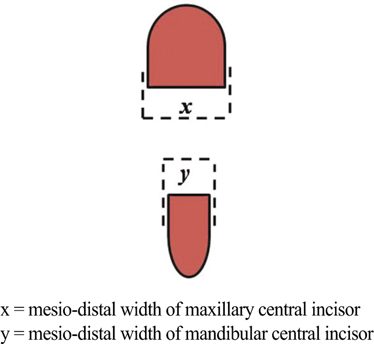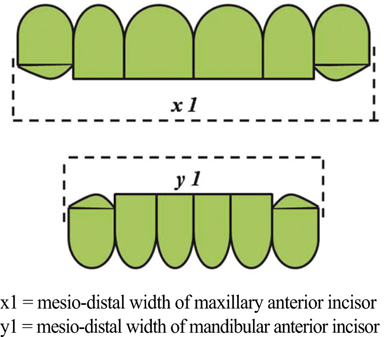J Adv Prosthodont.
2012 May;4(2):72-75.
Golden proportion assessment between maxillary and mandibular teeth on Indian population
- Affiliations
-
- 1Department of Prosthodontics, SRM Dental College, Ramapuram, Chennai, India. drgopichander@gmail.com
- 2Department of Prosthodontics, Priyadarshini Dental College, Chennai, India.
- 3Department of Prosthodontics, Sri Venkateshwara Dental College, Chennai, India.
Abstract
- PURPOSE
This study evaluated the existence of golden proportion between the widths of the maxillary and mandibular anterior teeth in Indian population.
MATERIALS AND METHODS
The clinical tooth width measurements were recorded with the digital vernier calipers on 576 patients of both sexes in the age group of 21 - 30 years. Flexible ruler was used to determine the width of maxillary and mandibular anterior teeth on the patients by the same operator. The data obtained was statistically analyzed using paired student t-test (alpha=.05).
RESULTS
The golden proportion was not found between the width of the right central and lateral incisors in 53% of women and 47% of men. The results revealed the golden percentage was rather inconstant in terms of relative tooth width.
CONCLUSION
The golden proportion is an inappropriate method to relate the successive widths of the maxillary anterior teeth in Indian population.
Keyword
Figure
Reference
-
1. Lombardi RE. The principles of visual perception and their clinical application to denture esthetics. J Prosthet Dent. 1973. 29:358–382.2. Ward DH. Proportional smile design using the recurring esthetic dental (red) proportion. Dent Clin North Am. 2001. 45:143–154.3. Morley J, Eubank J. Macroesthetic elements of smile design. J Am Dent Assoc. 2001. 132:39–45.4. Levin EI. Dental esthetics and the golden proportion. J Prosthet Dent. 1978. 40:244–252.5. Snow SR. Esthetic smile analysis of maxillary anterior tooth width: the golden percentage. J Esthet Dent. 1999. 11:177–184.6. Ricketts RM. The biologic significance of the divine proportion and Fibonacci series. Am J Orthod. 1982. 81:351–370.7. Mizumoto Y, Deguchi T Sr, Fong KW. Assessment of facial golden proportions among young Japanese women. Am J Orthod Dentofacial Orthop. 2009. 136:168–174.8. Murthy BV, Ramani N. Evaluation of natural smile: Golden proportion, RED or Golden percentage. J Conserv Dent. 2008. 11:16–21.9. Bukhary SM, Gill DS, Tredwin CJ, Moles DR. The influence of varying maxillary lateral incisor dimensions on perceived smile aesthetics. Br Dent J. 2007. 203:687–693.10. Ali Fayyad M, Jamani KD, Agrabawi J. Geometric and mathematical proportions and their relations to maxillary anterior teeth. J Contemp Dent Pract. 2006. 7:62–70.11. George S, Bhat V. Inner canthal distance and golden proportion as predictors of maxillary central incisor width in south Indian population. Indian J Dent Res. 2010. 21:491–495.12. Preston JD. The golden proportion revisited. J Esthet Dent. 1993. 5:247–251.13. Mahshid M, Khoshvaghti A, Varshosaz M, Vallaei N. Evaluation of "golden proportion" in individuals with an esthetic smile. J Esthet Restor Dent. 2004. 16:185–192.14. Ward DH. Proportional smile design using the recurring esthetic dental (red) proportion. Dent Clin North Am. 2001. 45:143–154.15. Gillen RJ, Schwartz RS, Hilton TJ, Evans DB. An analysis of selected normative tooth proportions. Int J Prosthodont. 1994. 7:410–417.16. Rosenstiel SF, Ward DH, Rashid RG. Dentists' preferences of anterior tooth proportion-a web-based study. J Prosthodont. 2000. 9:123–136.17. Vegter F, Hage JJ. Clinical anthropometry and canons of the face in historical perspective. Plast Reconstr Surg. 2000. 106:1090–1096.18. Bell RA. The geometric theory of selection of artificial teeth: is it valid? J Am Dent Assoc. 1978. 97:637–640.19. Latta GH Jr, Weaver JR, Conkin JE. The relationship between the width of the mouth, interalar width, bizygomatic width, and interpupillary distance in edentulous patients. J Prosthet Dent. 1991. 65:250–254.20. Basting RT, da Trindade Rde C, Flòrio FM. Comparative study of smile analysis by subjective and computerized methods. Oper Dent. 2006. 31:652–659.21. Al Wazzan KA. The relationship between intercanthal dimension and the widths of maxillary anterior teeth. J Prosthet Dent. 2001. 86:608–612.22. Ahmad I. Geometric considerations in anterior dental aesthetics: restorative principles. Pract Periodontics Aesthet Dent. 1998. 10:813–822.23. Koury ME, Epker BN. Maxillofacial esthetics: anthropometrics of the maxillofacial region. J Oral Maxillofac Surg. 1992. 50:806–820.24. Scolozzi P, Momjian A, Courvoisier D. Dentofacial deformities treated according to a dentoskeletal analysis based on the divine proportion: are the resulting faces de facto "divinely" proportioned? J Craniofac Surg. 2011. 22:147–150.25. Simon J. Using the golden proportion in aesthetic treatment: a case report. Dent Today. 2004. 23:82. 84.26. Javaheri DS, Shahnavaz S. Utilizing the concept of the golden proportion. Dent Today. 2002. 21:96–101.27. Jahanbin A, Basafa M, Alizadeh Y. Evaluation of the Divine Proportion in the facial profile of young females. Indian J Dent Res. 2008. 19:292–296.28. Decker JD. The divine proportion. Am J Orthod Dentofacial Orthop. 2004. 126:19A–20A.29. Sarver DM, Ackerman MB. Dynamic smile visualization and quantification: Part 2. Smile analysis and treatment strategies. Am J Orthod Dentofacial Orthop. 2003. 124:116–127.30. Marquardt SR. Marquardt on the Golden Decagon and human facial beauty. Interview by Dr. Gottlieb. J Clin Orthod. 2002. 36:339–347.31. Howells DJ, Shaw WC. The validity and reliability of ratings of dental and facial attractiveness for epidemiologic use. Am J Orthod. 1985. 88:402–408.32. Amoric M. The golden number: applications to cranio-facial evaluation. Funct Orthod. 1995. 12:18–21. 24–25.33. Phillips C, Trentini CJ, Douvartzidis N. The effect of treatment on facial attractiveness. J Oral Maxillofac Surg. 1992. 50:590–594.34. Wolfart S, Thormann H, Freitag S, Kern M. Assessment of dental appearance following changes in incisor proportions. Eur J Oral Sci. 2005. 113:159–165.35. Hasanreisoglu U, Berksun S, Aras K, Arslan I. An analysis of maxillary anterior teeth: facial and dental proportions. J Prosthet Dent. 2005. 94:530–538.36. de Castro MV, Santos NC, Ricardo LH. Assessment of the "golden proportion" in agreeable smiles. Quintessence Int. 2006. 37:597–604.37. Ong E, Brown RA, Richmond S. Peer assessment of dental attractiveness. Am J Orthod Dentofacial Orthop. 2006. 130:163–169.38. Wolfart S, Quaas AC, Freitag S, Kropp P, Gerber WD, Kern M. Subjective and objective perception of upper incisors. J Oral Rehabil. 2006. 33:489–495.39. Shell TL, Woods MG. Facial aesthetics and the divine proportion: a comparison of surgical and non-surgical class II treatment. Aust Orthod J. 2004. 20:51–63.
- Full Text Links
- Actions
-
Cited
- CITED
-
- Close
- Share
- Similar articles
-
- Does the maxillary anterior ratio in Korean adults follow the Golden Proportion?
- A radiographic study on root resorption in the malocclusion patients before orthodontic treatment
- Correlations between mesiodistal crown diameters of permanent teeth
- Assessment of Root and Root Canal Morphology of Human Primary Molars using CBCT
- The characteristics of Korean multi-rooted teeth root trunk extracted by periodontal disease



